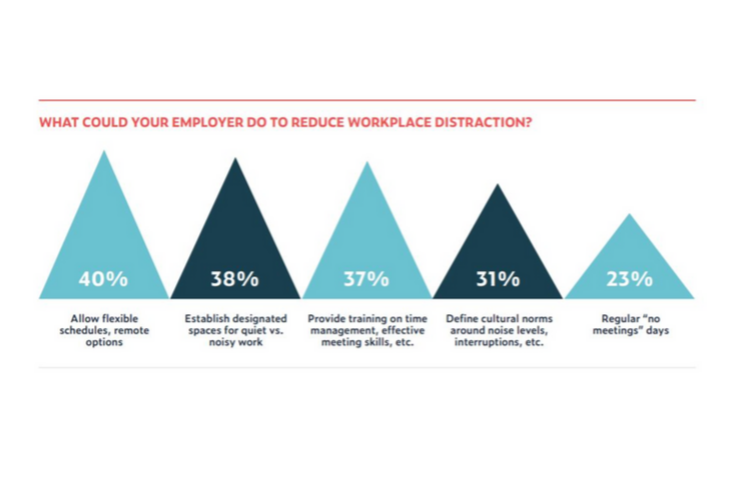- New research by Udemy shows that distracting workplaces cause stress, unhappiness, and frustration.
- Specifically, 80% of workers struggle to concentrate around chatty coworkers and 70% are affected by office noise.
- Companies can help combat distractions by offering flexible schedules, training, and better utilization of workspace, such as creating ‘me and we’ spaces.
Udemy’s Workplace Distraction Report found that “noisy, interruption-prone offices make employees unmotivated, stressed, and frustrated.” This affects a company’s bottom line, as it negatively impacts productivity levels and it can lead to disengaged employees.
“Companies would be wise to acknowledge the challenges their workers have staying focused and provide training on soft skills like communication and time management to help maintain productivity.”
Other reports have found similar detrimental effects that distractions can have on knowledge workers. Gloria Mark, from UC Irvine, has found that checking email and logging into social media “siphon off a lot more time than we think,” arguing that it takes almost half an hour or longer to return to our original tasks.
While “self-inflicted” distractions (smartphone use, social media) are common (69%), Udemy’s research found that the top distractors were workplace elements, specifically chatty coworkers (80%) and office noise (70%). Many workers also stated that productivity and communication tools (like Slack and Trello) are also distracting.
Suggested Reading: “The ABCs of Acoustics: 3 Ways to Reduce Noise in Open Workspaces”
It’s no wonder then that employees are “stressed, unmotivated, and feeling bad about themselves, their jobs, and their careers.”
Findings argue that because people compensate for interruptions by working faster, this leads to even more stress, higher frustration, time pressure, and effort. It’s a distraction overload.
Key Facts & Figures about Workplace Distraction
- 59% agree that personal use of technology is more distracting than work tools.
- Prime time for distraction hits at midday, with 46% answering that noon to 3pm is their most distracted period.
- Among millennials and Gen Z, 22% feel distractions prevent them from reaching their full potential and advancing in their careers.
- 43% of workers turn off their phones during work hours to minimize distractions.
- 92% have found it effective to turn their phones on airplane mode or do not disturb mode when they need to focus.
- 30% of workers use music, meditation, and other relaxation techniques to cope with distractions.
- 26% fill time with simple tasks that don’t require much focus to get back on track.
- 70% of workers believe training could help them get better at blocking out distractions and achieving focus.
- 60% of survey respondents said meetings are just another distraction from the work they need to complete.
What Can Companies Do?
Companies should prioritize reducing workplace distractions for various reasons:
- 75% of workers feel that they are more productive and get more done when they are not distracted.
- 49% state being happier at work.
- 57% feel more motivated to do their best when they are not distracted.
- 44% believe they deliver higher quality work.
- 51% feel more confident about their ability to do their job well.
The above all translates into improved productivity levels, which can improve a company’s overall performance. But more importantly, companies need to address this distraction problem because it can damage employee morale and retention. Talent attraction and retention is the number one challenge most companies are facing today, and the war for talent is expected to get fiercer.
There are a few strategies that companies can implement to address the problem, starting by providing training options. However, “training alone won’t solve the distraction issue.” Workers believe that they and their company would benefit from offering flexible schedules and remote options; providing both “me” and “we” spaces; provide training on time management and effective meeting skills; define cultural norms around noise levels and interruptions; and having “no meetings” days.

“Workplace distractions are only going to increase at the rate we’re going, but companies with a learning culture can stay attuned to where employees are struggling and design solutions and trainings that speak directly to their needs.”
What Can Workers Do?
Besides turning their phones off, there are a few strategies that workers can implement to stay focused at work:
- Use focus tools and techniques like the Pomodoro Technique
- Stop multitasking
- Eliminate visual distractions by organizing their desk
- Take regular short breaks
- Invests in noise cancelling headphones (particularly useful for those who work out of shared environments)
- Prioritize tasks and break tasks into chunks to make them more manageable
- Schedule meetings only when they are needed and keep them brief and straight to the point
- Set deadlines for yourself.


 Dr. Gleb Tsipursky – The Office Whisperer
Dr. Gleb Tsipursky – The Office Whisperer Nirit Cohen – WorkFutures
Nirit Cohen – WorkFutures Angela Howard – Culture Expert
Angela Howard – Culture Expert Drew Jones – Design & Innovation
Drew Jones – Design & Innovation Jonathan Price – CRE & Flex Expert
Jonathan Price – CRE & Flex Expert












